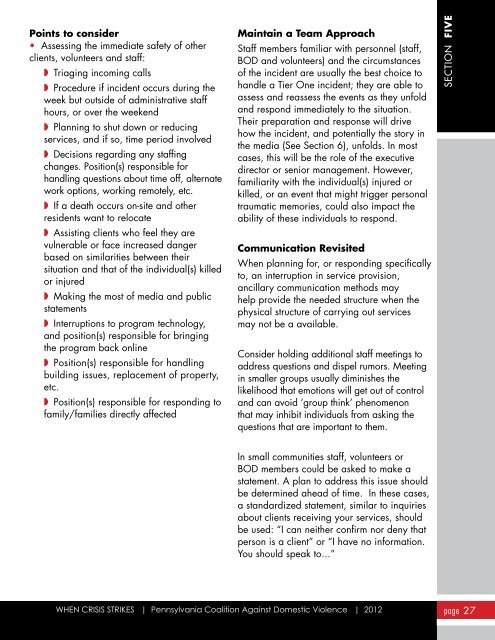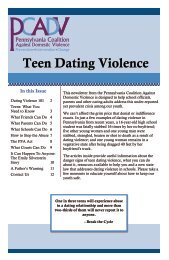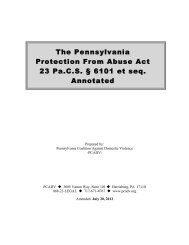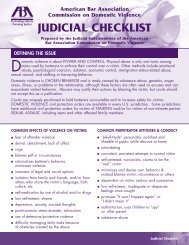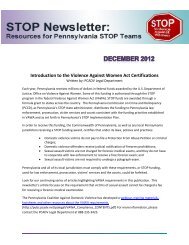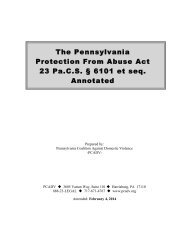Toolkit with Report Form - Pennsylvania Coalition Against Domestic ...
Toolkit with Report Form - Pennsylvania Coalition Against Domestic ...
Toolkit with Report Form - Pennsylvania Coalition Against Domestic ...
You also want an ePaper? Increase the reach of your titles
YUMPU automatically turns print PDFs into web optimized ePapers that Google loves.
Points to consider<br />
• Assessing the immediate safety of other<br />
clients, volunteers and staff:<br />
◗ Triaging incoming calls<br />
◗ Procedure if incident occurs during the<br />
week but outside of administrative staff<br />
hours, or over the weekend<br />
◗ Planning to shut down or reducing<br />
services, and if so, time period involved<br />
◗ Decisions regarding any staffing<br />
changes. Position(s) responsible for<br />
handling questions about time off, alternate<br />
work options, working remotely, etc.<br />
◗ If a death occurs on-site and other<br />
residents want to relocate<br />
◗ Assisting clients who feel they are<br />
vulnerable or face increased danger<br />
based on similarities between their<br />
situation and that of the individual(s) killed<br />
or injured<br />
◗ Making the most of media and public<br />
statements<br />
◗ Interruptions to program technology,<br />
and position(s) responsible for bringing<br />
the program back online<br />
◗ Position(s) responsible for handling<br />
building issues, replacement of property,<br />
etc.<br />
◗ Position(s) responsible for responding to<br />
family/families directly affected<br />
Maintain a Team Approach<br />
Staff members familiar <strong>with</strong> personnel (staff,<br />
BOD and volunteers) and the circumstances<br />
of the incident are usually the best choice to<br />
handle a Tier One incident; they are able to<br />
assess and reassess the events as they unfold<br />
and respond immediately to the situation.<br />
Their preparation and response will drive<br />
how the incident, and potentially the story in<br />
the media (See Section 6), unfolds. In most<br />
cases, this will be the role of the executive<br />
director or senior management. However,<br />
familiarity <strong>with</strong> the individual(s) injured or<br />
killed, or an event that might trigger personal<br />
traumatic memories, could also impact the<br />
ability of these individuals to respond.<br />
Communication Revisited<br />
When planning for, or responding specifically<br />
to, an interruption in service provision,<br />
ancillary communication methods may<br />
help provide the needed structure when the<br />
physical structure of carrying out services<br />
may not be a available.<br />
Consider holding additional staff meetings to<br />
address questions and dispel rumors. Meeting<br />
in smaller groups usually diminishes the<br />
likelihood that emotions will get out of control<br />
and can avoid ‘group think’ phenomenon<br />
that may inhibit individuals from asking the<br />
questions that are important to them.<br />
Section five<br />
In small communities staff, volunteers or<br />
BOD members could be asked to make a<br />
statement. A plan to address this issue should<br />
be determined ahead of time. In these cases,<br />
a standardized statement, similar to inquiries<br />
about clients receiving your services, should<br />
be used: “I can neither confirm nor deny that<br />
person is a client” or “I have no information.<br />
You should speak to...”<br />
When Crisis Strikes | <strong>Pennsylvania</strong> <strong>Coalition</strong> <strong>Against</strong> <strong>Domestic</strong> Violence | 2012 page 27


